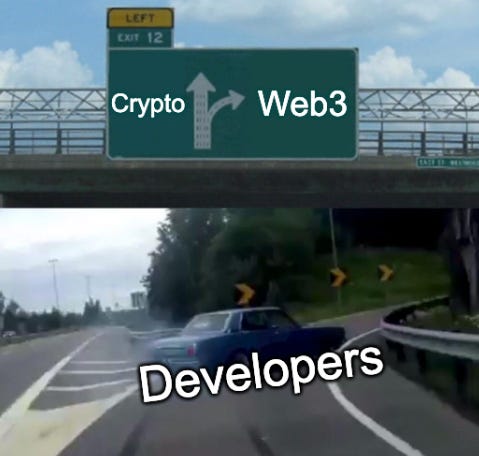Crypto v Web3 - What's the difference?
I often talk to crypto natives about “web3” and quickly realize we are talking about rather different things. What follows below is my perspective as a web3 builder with the usual caveat that there is no right or wrong definition of these things and they will evolve over time.
There is significant prior art here, so I’d like to acknowledge Gavin Wood’s original blog post defining Web 3.0 and Jesse Waldon’s post on “crypto” v “web3” that talks to some of the tribalism behind these words.
Crypto: Own your Assets
At the risk of oversimplification, the objective of “crypto” is for an individual to own their assets. This can be enabled by holding tokens or NFTs which can be exchanged through decentralized exchanges or marketplaces.
This can be broken down as follows:
Infrastructure
Key management (Seed phrase, private key, social recovery)
Protocol networks (Bitcoin, Ethereum, NEAR etc.)
Protocol tokens (BTC, ETH, NEAR etc.)
Standards (ERC-20 Token standard, ERC-721 NFTs etc.)
Crypto wallets (Metamask, Rainbow wallet, Verida wallet)
Apps
DEX (Uniswap, Pancake Swap, Balancer)
Project tokens (Decentraland, Bankless, Sandbox)
Web3: Own Everything
The intent of web3 is for an individual to own every part of their digital life.
Own your identity. Own your data. Own your assets. Everything is encrypted. Everything is verifiable. Everything is controlled by you.
This can be broken down as follows:
All of “Crypto”
Web3 encompasses all the infrastructure and apps of crypto.
Infrastructure
Identity (DIDs)
Auth (Sign in with Ethereum, WalletConnect, Verida SSO)
Data storage (Textile, Ceramic, Verida DbStore)
Messaging (EPNS, WalletConnect Chat, nostr, Verida Messaging)
Web3 wallets (Onto, Verida Wallet)
Apps
Social (Farcaster, Damus, Gm.xyz, Verida.one)
Identity / Credentials (Gitcoin Passport, Disco.xyz, Galxe, Keloverse)
Content (mirror.xyz)
Why is the distinction important?
Web3 has the potential to disrupt every single industry, not just finance. It is the key to unlocking mass adoption of decentralized technology beyond the tech savvy.
The economic model, consensus model and underlying technologies are different for each part of the web3 stack. Developers, infrastructure providers and investors need to understand these differences and not apply pre-existing “crypto” thinking to “web3”.
For example, there are significant differences between L1 and L2 blockchains; different consensus models, different economic models, different objectives. Similarly in Web3 there are differences between public and private data storage protocols; different performance criteria, different security threats etc.
The distinction is important, however it doesn’t really matter what it is called. It is important we can have a shared language to efficiently communicate ideas and evolve our collective thinking.
The challenges ahead
The crypto audience is a small subset of the wider population that is more tech savvy and will do the work to get around poor user experiences. Web3 aims to cross over to mainstream adoption. This requires closing the gap between the current (poor) crypto user experiences, to something anyone with a mobile device and web browser can easily use to access the full web3 technology stack.
A significant user experience gap exists across the current crypto infrastructure stack, whereas the Web3 infrastructure stack is earlier in its development cycle. It has even more ground to make up.
For example, we require better user experiences for login that aligns more closely with web2 expectations. Users expect fast and responsive apps that are limited today by blockchain speed and data storage speed. These issues need to be addressed (and will be) on the road to mass adoption of web3.
The opportunity ahead
Where there are challenges, there are opportunities.
We are early. The introduction of decentralized technology has the potential to disrupt every industry, every governance structure and break the monopolistic control of existing incumbents.
The next generation of infrastructure and applications are in their nascent stages right now. Due to the community oriented nature of crypto and web3, everyone has an opportunity to participate regardless of their experience or skills.
Find a problem where you can add value and jump in!


